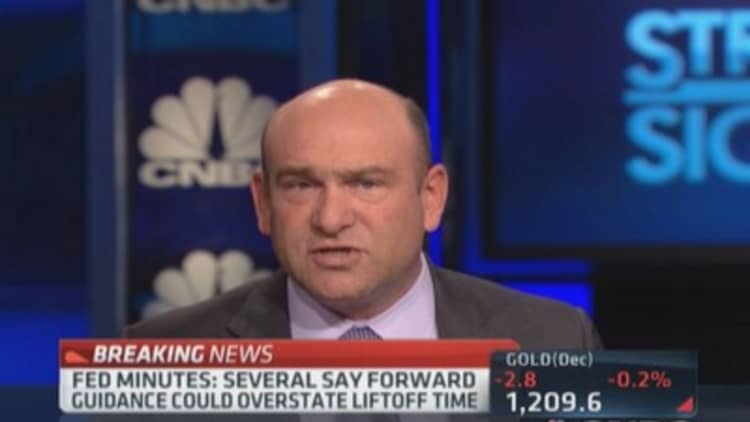
The Federal Open Market Committee debated whether the current language painted the wrong picture on the timing of rate hikes, with the outcome being agreement that rate hikes would depend on data and not a calendar date, according to minutes released Wednesday.
Fed staff also cut their growth outlook due to the higher dollar, as a number of committee participants expressed concern about global weakness.
Most members of the committee want the current guidance clarified to emphasize that the timing of a rate hike is data dependent, according to the minutes. Concerns were raised that the current language could be misunderstood as a commitment.
"The concern was raised that the reference to 'considerable time' in the current forward guidance could be misunderstood as a commitment rather than as data dependent," the minutes said.
"It was emphasized that the current forward guidance for the federal funds rate was data dependent and did not indicate that the first increase in the target range for the federal funds rate would occur mechanically after some fixed calendar interval following the completion of the current asset purchase program," the statement added.
Markets quickly rallied on the news as traders grew assured that the central bank remains committed to keeping interest rates lower until it is convinced the economy has healed sufficiently. The Dow rose more than 200 points a day after suffering its fourth-worst loss of the year. Bond yields dropped, with the five-year Treasury sliding to 1.57 percent from 1.63 percent.
Judging by statement in the minutes, that time has not come.
"Many participants revised down their projections of real GDP growth somewhat in one or more years and particularly for 2015, compared with their projections in June," the minutes said. "Participants pointed to a couple of factors leading them to mark down their projected paths for real GDP growth including the incorporation of weaker-than-expected data on consumer spending and perceptions of slower growth in potential GDP."
This is breaking news. Check back for updates.
Read MoreMore Federal Reserve coverage
The Fed remained on its easy-money course at last month's meeting, allaying market fears that it might start raising interest rates sooner than expected. Chair Janet Yellen reiterated that any move in rates will be "data-dependent" on not based on a calendar projection.
In a statement released Sept. 17 following its two-day meeting, the U.S. central bank left largely intact key provisions, despite expectations in some quarters that it would indicate a tightening bias. It also cut its bond-buying program down to $15 billion a month and indicated quantitative easing would end in October.
Most importantly, the Fed's Open Market Committee did not remove language that said interest rates would rise "a considerable time" after the monthly bond-buying program ended.
Essentially, the Fed believes that its historically accommodative policy, which has pushed its balance sheet past $4.5 trillion, is necessary to achieve its dual goals of price stability and maximum employment. The unemployment rate dropped to 5.9 percent in September, but largely to due a declining percentage of Americans considered in the labor force, while inflation remains subdued at 1.6 percent annually, according to the gauge the Fed uses.
"Participants provided a number of reasons why they thought it would be appropriate for the federal funds rate to remain below its longer-run normal level for some time after inflation and unemployment were near mandate-consistent levels," the minutes said.
"These reasons included an assessment that headwinds holding back the recovery will continue to exert restraint on economic activity at that time and that the risks to the economic outlook are asymmetric as a result of the constraints on monetary policy caused by the effective lower bound on the federal funds rate."
The FOMC voted 10-2 to approve the language, with Dallas Fed President Richard Fisher and Philadelphia President Charles Plosser opposed.
Correction: An earlier version incorrectly identified Charles Plosser as president of the Richmond Fed.


